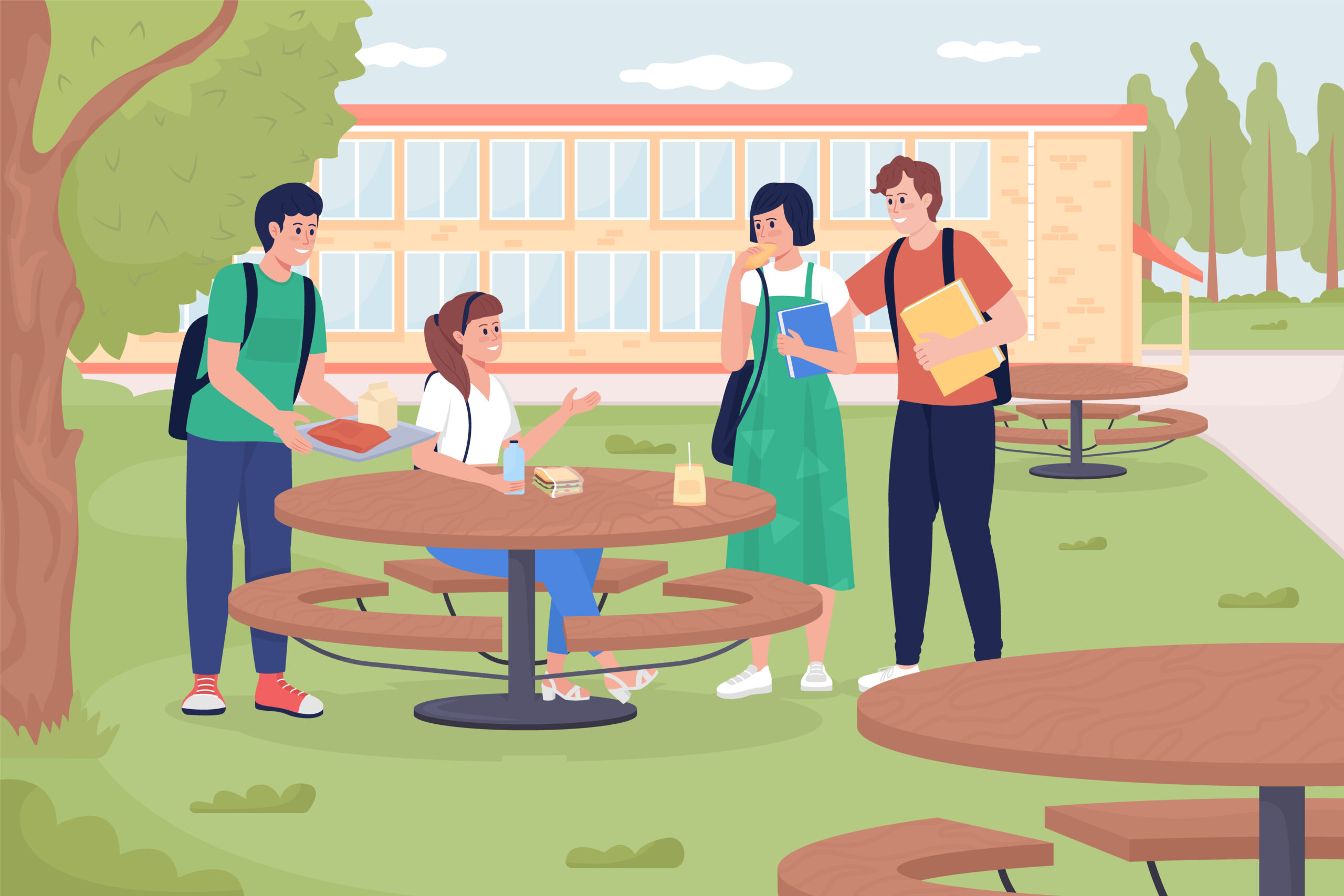When parents tour campuses with their high school seniors, one of the first stops on the admissions circuit is almost always the dining hall. For many families, this is the moment when their eyes widen, and their wallets open. Students see bustling rooms filled with peers, endless buffet lines, and a seemingly infinite range of choices. Mom and Dad see abundance. Security. Assurance. Their child will never go hungry here.
It’s textbook marketing psychology, and higher education dining departments, often supported by food service contractors, know it. The message is loud and clear: “Look at all this food. Look at the variety. Look at the community.” The parents’ instinct is primal: Our baby will be taken care of.
That’s why the most expensive meal plans sell themselves. The price tag might be steep, but it feels justified when framed against the cost of college itself, and against the universal parental fear of scarcity.
The Fantasy of Abundance
First impressions of campus dining are almost always tied to the residential dining hall(s). These spaces serve as the showpiece during tours, gleaming, bustling, and designed to overwhelm the senses with choice. It feels like a modern-day Hogwarts: long tables, lively chatter, food everywhere, and a sense of community that promises belonging.
This is the fantasy that parents and students buy into: abundance as a guarantee of care, safety, and inclusion. The dining hall is the heart of campus life, the beating hub where freshmen will form friendships and find their footing.
But once the semester begins, the fantasy often dies a swift demise. Why? Because the actual dining program isn’t set up to reinforce the residential hall experience, it’s structured to steer students away from those dining halls and into retail locations on campus, using meal equivalencies and declining balance dollars.
The result: instead of living the Hogwarts dream, students experience a fragmented, transactional reality. They swipe into retail chains for grab-and-go meals. They stretch declining balances to get through the semester. And they quickly discover that the “all-you-care-to-eat” centerpiece of campus life is far less available, accessible, and satisfying than they were led to believe.
Abundance Turns into Scarcity
The paradox is simple: the very plans that sell themselves so easily often become the least loved once students are living the reality.
Instead of endless abundance, students bump into scarcity:
- Limited hours of operation. Dining halls often close far earlier than a student’s schedule allows. What felt like “all-you-care-to-eat” on a tour suddenly looks like “all-you-care-to-eat, but only if you show up between 11:00 a.m. and 1:30 p.m.” or “before 7:00 p.m.”. For students in evening labs, athletic practices, or part-time jobs, those hours simply don’t work.
- Lite breakfast, lite lunch. Off-peak meals are scaled back to “continental” or “grab-and-go” options. Students expecting hot eggs, protein, or a full lunch may be greeted with fruit, a bagel, or yesterday’s soup.
- Weekend austerity. Many dining halls shut down altogether; others limp along with reduced menus and shorter hours that don’t match student life. For night owls, athletes, or students staying on campus, “weekend service” feels more like a penalty than a privilege.
- Unpredictable and inconsistent menus. Students walk into dining halls not knowing what they’ll get, or worse, knowing what they won’t get, because their favorites run out fast.
- Running out of food. Nothing frustrates students more than standing in line for a popular entrée only to see the pan empty right before their turn. Replenishment is often slow or doesn’t happen at all.
It doesn’t take long before students start calculating the cost per meal and realizing they could “buy down” to a cheaper plan or eat off-campus for less. The initial sense of abundance feels like a bait-and-switch.
The Inferior Program Penalty
What’s worse, students quickly sense that the “big plan” punishes them. Let’s call it the inferior program penalty.
Here’s how it plays out:
- Limited Hours of Operation. The biggest frustration is when dining halls aren’t open when students need them. Early-morning athletes, STEM majors with evening labs, and students working part-time jobs often discover that the “all-access” plan doesn’t actually grant them access when they’re hungry. The doors are locked, the options scaled down, or the venues closed altogether. The result: missed meals that families already paid for.
- Craveables. Every campus has a short list of “craveables,” the foods students don’t just eat, they expect fries, burgers, milkshakes, mac and cheese, chicken tenders, pizza, and cultural comfort foods like ramen or tacos. These aren’t luxuries; they’re staples of student life, emotional touchpoints, and social magnets. When these items run out or are rotated inconsistently, students feel robbed. They came for their go-to, but instead are faced with an uninspired substitute or an empty pan. This inconsistency undermines trust in the whole program.
- Weekend Withdrawal. Ask any freshman who sticks around campus over the weekend: “What’s it like in the dining hall on a Saturday night?” The answer is usually some combination of lonely, underwhelming, and limited. Students paying top dollar expect consistent service, not austerity.
- Running Out of Options. Whether it’s burgers, burritos, or a specialty station, when popular items run out, students see it as a broken promise. They were sold “all-you-care-to-eat,” not “all-you-care-to-eat until we run out.”
- The Real Penalty: Paying Twice.
This is where the paradox bites hardest. Frustrated by missed meals, closed halls, or the absence of their craveables, students turn to off-campus food or third-party delivery. DoorDash, Uber Eats, and local restaurants suddenly become lifelines, funded not by their declining balance, but by mom and dad’s credit card.
The irony is staggering: families already paid thousands for the “all-access” plan, yet students still spend hundreds, if not thousands, more each semester and academic year to cover the gaps. Parents quickly realize the big meal plan wasn’t a safety net; it was a mirage, a fixed cost that still requires supplemental spending.
In other words, the inferior program penalty is the out-of-pocket cash drain layered on top of the expensive meal plan. Students resent it, parents feel misled, and universities see participation drop as soon as students are allowed to buy down or opt out.
Parents Buy Security; Students Live the Reality
Parents are sold security. They buy the most expensive plan with pride, believing they’ve guaranteed their student’s food needs. It feels like love expressed in dollars.
But students don’t live in the brochure. They live in the dining hall, and the retail chains they’re funneled into, and when their daily experience doesn’t line up with what their parents believed they bought, the fallout is twofold:
- Students want out. They look for loopholes, buy down to smaller plans, or petition for exemptions. They grumble about fairness and talk about how much cheaper it is to eat at Chipotle, Panera, or a food truck off campus.
- Parents lose trust. When their student calls home complaining, parents start asking themselves if the university oversold them. Word spreads quickly in parent Facebook groups, orientation sessions, and campus tours. One disappointed student becomes ten cautious families.
The very program that once felt like a “security blanket” now feels like a “straitjacket.”
Why This Matters: Retention, Occupancy, and Reputation
Universities often underestimate how dining impacts student retention, housing occupancy, and institutional reputation.
- Retention. Students who feel nickel-and-dimed or underserved by their dining experience are more likely to disengage socially. Dining halls are supposed to be social epicenters, places where freshmen build networks and friendships in the critical first six weeks. When food becomes a frustration point, that opportunity is lost. Research shows that social integration is one of the most powerful predictors of persistence into sophomore year.
- Housing Occupancy. Students stuck in mandatory meal plans tied to residence halls will increasingly look to move off campus once the requirement ends. Empty beds are expensive. Every 100-bed shortfall in occupancy is equivalent to losing millions of dollars in housing and meal revenue.
- Reputation. Dining is the most visible day-to-day service on campus. When it underdelivers, it poisons word of mouth. Prospective students hear about “bad food” and “limited hours” more than they hear about faculty accolades or cutting-edge labs.
The Path Forward
The good news: the paradox isn’t inevitable. Institutions that approach dining with courage, clarity, and strategy, developing Next Generation Residential and Retail Dining Programs crafted through the lens of SOCIAL ARCHITECTURE™, can avoid the bait-and-switch altogether.
- Transparency Over Marketing Spin. Show parents and students what real dining looks like. If you’re serving a light breakfast most weekdays, say it. If weekend service is reduced, make it clear. Honesty builds trust.
- Align Hours with Student Life. Dining schedules must map onto the rhythms of student life, not administrative convenience. Athletes, STEM majors, and student performers have unique schedules, and they pay tuition, too.
- Consistency of Offerings. If a menu item is on the plan, it must be available. Running out of food is unacceptable. Replenishment should be a baseline standard, not a “nice to have.”
- Late Night Matters. Students bond late at night. Providing substantial food options after 9 p.m. pays dividends in SOCIAL ARCHITECTURE™. A vending machine is not a late-night dining strategy.
- Measure What Matters. Stop measuring only cost-per-plate. Measure meal participation rates and voluntary plan sales. If students are opting out whenever they can, the message is clear: the value proposition is broken.
- Design for SOCIAL ARCHITECTURE™. Dining halls are more than feeding stations. They are the heartbeat of the community. Design spaces and programs that encourage face-to-face interaction, friendship formation, and belonging. That’s what keeps students enrolled, housed, and engaged.
The freshman meal plan paradox is real. Parents buy abundance because they’re shown abundance, the modern-day Hogwarts fantasy. Students live in scarcity because the day-to-day program is engineered around cost control, retail steering, and operational convenience, not student experience.
The result? Students want out. Parents lose trust. Universities pay the price in retention, housing occupancy, and reputation.
But the solution is not complicated: courage, clarity, and action. When institutions see dining not as a cost center but as a cornerstone of SOCIAL ARCHITECTURE™, they can flip the script. Meal plans become tools of engagement, belonging, and success.
The good news is clear: the paradox isn’t inevitable. Institutions that develop Next Generation Residential and Retail Dining Programs crafted through the lens of SOCIAL ARCHITECTURE™ can avoid the bait-and-switch altogether and instead deliver on the promise of dining as the heartbeat of student success.










